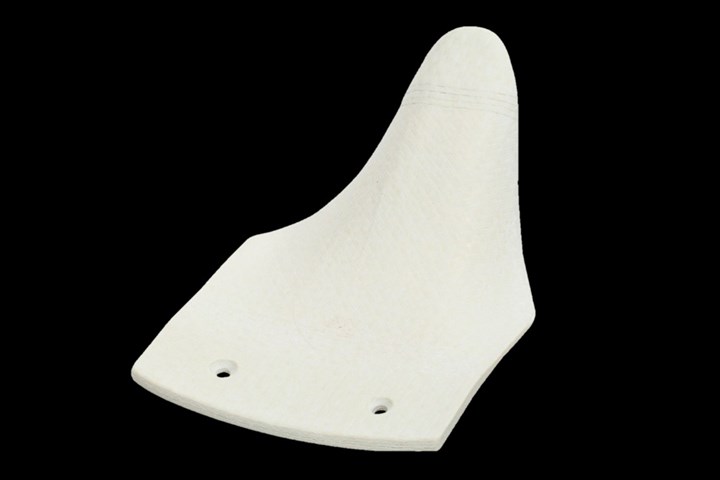3M launches high-temperature, oxidation-stable Nextel ceramic fabric
Nextel 610 DF-13-4500 ceramic fabric allows ceramic composites to compete with metal components, with comparable performance and reduced cost.

Example of an Ox-Ox CMC part created using Nextel fabric. Source | Composites Horizons Inc.
3M (St. Paul, MN, U.S.) launched on July 17 its Nextel DF-13-4500, a 610 fabric that can be used to make oxide-oxide (ox-ox) ceramic matrix composite (CMC) parts as an alternative to metal components. A continuous aluminum oxide (alpha alumina) fiber that can be woven into fabrics, Nextel 610 is typically used to reinforce composite parts and provide structural integrity even at continuous temperatures of up to 1000°C. According to 3M, Nextel DF-13-4500 is the company’s highest denier Nextel fabric from the Nextel 610 portfolio, enabling improved material efficiency while maintaining the benefits of ox-ox CMCs.
Ox-ox CMCs are high-strength, high-temperature and oxidation-stable materials that expand the design flexibility, life expectancy and efficiency of parts compared to existing metal parts. Ox-ox CMCs are gaining increased use as a mainstream material option for high-temperature components, especially in the aerospace and advanced energy sectors, and are gaining attention in broader industrial markets.
“The launch of Nextel DF-13-4500 fabric is an important milestone for the 3M Nextel portfolio to continue to increase the market adoption of ox-ox CMCs. The higher denier fabric enables customers to achieve the benefits of ox-ox CMCs but finally at the price that’s more accessible and competitive to metals,” states Clara Choe, 3M advanced materials division’s Nextel global business development manager.

Nextel DF-13-4500 fabric close-up.
Ideal in aerospace applications, 3M notes that ox-ox CMCs enable aircraft to operate more efficiently via expanded engine temperature capability and lower weight. Customers, 3M says, can realize a weight reduction of up to 20% when using Nextel 610 compared to typical metal parts such as titanium alloys. Beyond aerospace, ox-ox CMCs reinforced with 3M Nextel fabrics have also reportedly seen success in industrial and fuel cell applications.
“Nextel DF-13-4500 fabric provides the potential to produce ox-ox CMC materials with mechanical properties that are consistent with CMC materials produced with the Nextel baseline fabric, DF-11, which uses 1500 denier roving,” explains 3M’s application development engineer, Stan Fast. “The ability to produce CMCs with comparable performance while reducing cost is what makes the DF-13-4500 material unique.”
Nextel DF-13-4500 is one of 3M’s commercial structural fabrics from the Nextel 610 and 720 portfolio. 3M says its portfolio of fabrics is also compatible with metal matrix composite (MMC) and polymer matrix composite (PMC) applications, the latter of which is used in a wide range of aviation applications including radomes, ducting and other structural components. Additionally, Nextel 610 fiber is said to offer characteristics that are desirable in the electronics industry, such as high modulus performance comparable or higher than high-modulus carbon fibers, which enable thin-walling and are radio frequency transparent. 3M is also exploring the use of Nextel in 5G infrastructure and telecommunication applications.
Learn more about the full Nextel portfolio.
Related Content
-
The future of quartz and oxide fibers at Saint-Gobain Advanced Ceramic Composites
New business builds on 100-year legacy in quartz, prepares for growth, while starting production of oxide fibers to meet increased demand for CMC by aerospace and industrial sectors.
-
L&L Special Furnace commissions high-temp box furnace for CMC parts
Multi-layer, high-temperature insulation, enables temperatures up to 1,700°C under partial atmospheric pressure for CMC parts production to be used in military and aerospace applications.
-
RATH prepares for production of advanced oxide ceramic fiber for CMC
New facility in Germany is part of regional supply chain and vision to lead green energy transition using CMC, supported by German government and Composites United’s Ceramic Composites network.
















